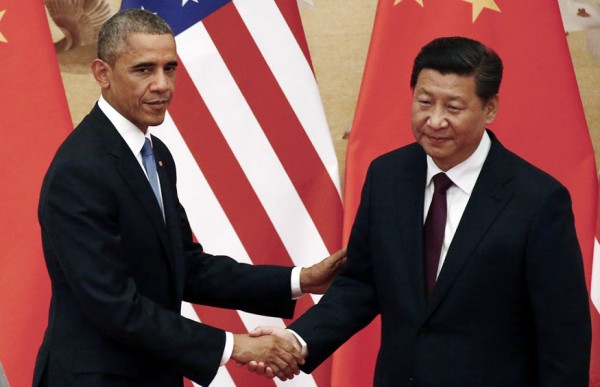US-China Bilateral Investment Treaty Showing Signs of Progress
| Marcel Woo | | Mar 04, 2015 08:35 AM EST |
U.S. President Barack Obama shakes hands with China's President Xi Jinping in front of U.S. and Chinese national flags during a joint news conference at the Great Hall of the People in Beijing November 12, 2014. REUTERS/Petar Kujundzic
A top US Stated Department official revealed that the ongoing talks for a bilateral investment treaty between the United States and China are showing signs of progress, even as the two countries have different opinions on several issues.
Catherine Novelli, Undersecretary of State for Economic Growth, Energy and the Environment, said the ongoing talks for the bilateral investment treaty between the US and China, the world's two biggest economies, are moving forward.
Like Us on Facebook
"They're going very well," Novelli told reporters during a news conference.
The bilateral investment treaty, when approved and implemented by Washington and Beijing, will expand trade between the US and China, even as the two countries recently clashed on various trade-related issues.
The latest meeting to discuss the treaty was held last February and China is not expected to submit its list of areas and sectors that are not open to foreign investment and, thus, will not be covered by the bilateral investment treaty.
Analysts and economists expressed confidence that the the bilateral investment treaty will be concluded before US President Barack Obama leaves office in two years.
"I think from the China point of view, time is of the essence" Mark Schwartz, chairman of Beijing-based Goldman Sachs Asia Pacific, told reporters.
Schwartz added that completing the bilateral investment treaty could a critical part of opening up China's market to more foreign competition.
"This is a deal that the Chinese have placed the highest priority on, and they are ready to make a deal," he said.
The US-China Business Council has urged the two countries to try and conclude the agreement within this year.
Deborah Lehr, a senior fellow at the Paulson Institute, one of the conveners of the talks, said a bilateral investment treaty would be good for China because the required opening of the market would bring in investments, encouraging more competition in the consumer and services sectors.
"That in turn would help China achieve its ambitious plan to transform its economic model away from export-led growth to a more consumption-based model," she said.
Lehr added that the treaty would also help clarify regulations for Chinese companies investing in the United States.
TagsUS-China Investment Treaty, US-China Business Deal, US-China BIT
©2015 Chinatopix All rights reserved. Do not reproduce without permission
EDITOR'S PICKS
-

Did the Trump administration just announce plans for a trade war with ‘hostile’ China and Russia?
-

US Senate passes Taiwan travel bill slammed by China
-

As Yan Sihong’s family grieves, here are other Chinese students who went missing abroad. Some have never been found
-

Beijing blasts Western critics who ‘smear China’ with the term sharp power
-

China Envoy Seeks to Defuse Tensions With U.S. as a Trade War Brews
-

Singapore's Deputy PM Provides Bitcoin Vote of Confidence Amid China's Blanket Bans
-

China warns investors over risks in overseas virtual currency trading
-

Chinese government most trustworthy: survey
-

Kashima Antlers On Course For Back-To-Back Titles
MOST POPULAR
LATEST NEWS
Zhou Yongkang: China's Former Security Chief Sentenced to Life in Prison

China's former Chief of the Ministry of Public Security, Zhou Yongkang, has been given a life sentence after he was found guilty of abusing his office, bribery and deliberately ... Full Article
TRENDING STORY

China Pork Prices Expected to Stabilize As The Supplies Recover

Elephone P9000 Smartphone is now on Sale on Amazon India

There's a Big Chance Cliffhangers Won't Still Be Resolved When Grey's Anatomy Season 13 Returns

Supreme Court Ruled on Samsung vs Apple Dispute for Patent Infringement

Microsoft Surface Pro 5 Rumors and Release Date: What is the Latest?











